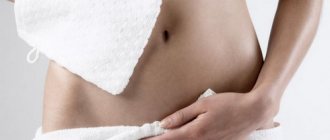Anatomy of the female external genitalia
The vulva (external genitalia) is the natural external “lock” of the vagina, formed due to the close (normal) contact of the inner surface of the labia minora and labia majora.
Tight closure of the genital slit directly depends on the integrity of the perineum and helps protect the vagina from contamination from the external environment. In addition, it prevents the penetration of air into the vagina and the rapid evaporation of vaginal secretions with drying (thickening) of the epithelium of the vaginal mucosa.
The labia minora are two longitudinal folds of skin that have a good blood supply and innervation system and contain a large number of glands.
The labia minora (normally) fit tightly together in the lower third. This explains the most common adhesion of the labia minora in this part. Fusion or gluing of the labia minora can be complete or incomplete and can occur at any site.
It is worth noting that this condition is very common among girls. It is observed from birth to 6-7 years. In newborn girls (up to 6 months), due to the presence of remnants of the estrogen hormone left by the mother, fusion is rare. However, with each month of life, estrogen reserves decrease, and there is a risk of sticking of the labia minora.
If you visit a forum for young mothers on the Internet or just talk with mothers on a walk, you can see that this condition occurs on average in every 5th girl.
There are many opinions among parents and doctors that sticking of the labia occurs due to poor hygiene. Let's figure it out!
When does a girl start puberty?
From birth, boys and girls have different body structures. The reproductive system of girls is divided into external and internal, and in turn they are closely interconnected with the nervous system.
Each girl begins to develop sexually individually and not simultaneously. Some girls are fully formed by the age of 13, while the body of other girls can only begin to begin this process in a year or even two.
A slight run-up is completely normal. This determines why some girls have already developed breasts and a round butt, while others have not yet. Let no one be confused by age restrictions, as this is just an approximate medical guideline.
Let's take a closer look at the sexual development of girls. It is divided into 2 phases:
- Presexual (starts at 8-9 years old and lasts about 5 years).
- Puberty (at about 13-14 years old, lasts until 18).
Read also: Fighting bad habits in a teenager
The 1st presexual phase begins when secondary sexual characteristics appear, it is then that the body begins to actively develop and a rapid rate of growth in height occurs. The presexual phase ends with the appearance of the first menstruation.
The 2nd phase - puberty begins when girls get their first period. This is approximately 13-14 years old. At this time, growth slows down and ovulatory cycles appear. The completion of the pubertal stage means the end of the girl’s sexual and somatic development. That is, now her body is ready to reproduce offspring (pregnancy).
The improvement of the mammary glands of girls begins with the growth of the breast nipples and their halos (halos are single or brown circles around the nipples). Then the girls’ mammary glands themselves begin to grow. Next comes the penultimate stage of breast development. Everything will finally take shape for a girl only after giving birth and breastfeeding her child.
Pubic hair begins to grow at about the same time as breast development. For some girls, pubic hair begins to grow a little earlier. At first, single hairs appear and over the course of about six months or even a year, the hair grows throughout the pubis and down to the anus.
Read also: Prevention of drug addiction in children. Effective steps
The figure is changing. During the pubertal phase of development in girls, a large number of hormones are actively produced in the body. At this time, the volume of adipose tissue increases. This layer of fat forms in the area of the mammary glands, gluteal muscles, shoulders and pubis.
Causes of pathology
What are the causes of fusion of the labia minora? There are several of them:
- fusion or sticking together of the labia minora occurs most often due to excessive washing of the girl with frequent use of fragrant soap. The famous children's doctor E. O. Komarovsky also speaks about this. He believes that it is enough to wash the girl with soap once a day (at night). Using soap, the mother washes away all the vaginal flora, thereby reducing its protection;
- the use of wet sanitary napkins also does a disservice;
- the use of diapers, their untimely change, when conditions are created not only for the labia to stick together, but also for the proliferation of pathogenic microorganisms;
- wearing tight underwear made of synthetic fabric;
- the result of an inflammatory process of the genital organs (vulvovaginitis), the urinary system;
- frequent swimming in dirty ponds leads to constant irritation, against the background of which the labia grow together quite often;
- allergic reactions when skin comes into contact with powder residues on clothing;
- The labia also stick together when taking medications or food allergens.
Menarche - first menstrual bleeding
Menarche - the first menstruation - appears at approximately 11-14 years of age. If a girl has her first period at this age, it means that her body is developing completely normally. If your period is absent by the age of 14, you should contact a pediatric gynecologist to understand the reasons and, possibly, begin treatment, read more.
Menstruation does not immediately begin to go cyclically; for some time it varies. In the beginning, they are short and irregular. At this time, girls may experience mood changes.
Mood swings are different for girls. For example, at first she is strong, cheerful, full of strength and hope, but after a while she is already dissatisfied with something and becomes passive and withdrawn into herself. Then she becomes passionate about something and after a while she is again dissatisfied with what is happening, for example, with her appearance.
Read also: Fighting bad habits in a teenager
Manifestations of labia fusion
Usually, if there is no associated urinary tract infection, there are no manifestations of fusion of the labia except visual ones.
At the next examination, the child’s mother or doctor may see a thin whitish film between the labia minora.
If there is an infection of the urinary system, when, due to the adhesion of the labia, the outflow of urine is disrupted (complete or almost complete fusion), discomfort appears when urinating, the child begins to strain intensely and cry due to pain.
In some advanced cases, a rise in body temperature is possible.
If urine constantly comes into contact with the skin of the lower abdomen or underwear, dermatitis may develop. If the nature of the fusion is allergic, then a rash may appear.
Treatment approaches
Conservative treatment
No matter how synechiae looks, it is recommended to start with conservative treatment, which includes several stages.
First, the cause is eliminated:
- in the presence of inflammation of the urinary system, antibacterial drugs and uroseptics are prescribed orally;
- for vulvitis and vulvovaginitis - local treatment with antibacterial, antiviral, antifungal drugs (depending on the pathogen);
- in case of a general inflammatory process (rhinitis, bronchitis, pneumonia, etc.), the underlying disease is treated together with a pediatrician;
- for allergies, antihistamines and a strict diet are prescribed;
- If hygiene rules are violated, recommendations are given to correct errors.
Secondly , sitz baths with herbal decoctions that help soften the adhesions. The duration of the bath is no more than five minutes.
Thirdly , applying hormonal drugs (ovestin, folliculin) or drugs used to resolve scars (contractubex) to the site of fusion. The treatment regimen is selected individually depending on the severity of the fusion.
The duration of use of hormonal drugs is two weeks. If necessary, the course of treatment can be repeated after a break.
Surgery
Surgical methods are resorted to if conservative treatment does not give the expected result. As a rule, a gynecologist using sterile instruments (Volkmann spoon, cytobrush, Eyre spatula) separates the fused labia in a antenatal clinic under local anesthesia, after which a synthomycin emulsion is applied to the vulva.
At home, to speed up healing, it is recommended to perform sitz baths with herbs and lubricate the vulva with 5 - 10% synthomycin emulsion or levomekol 2 times a day for 5 days.
It is extremely rare, in the case of “old” synechia, to resort to a scalpel. This procedure is performed in a hospital setting under general anesthesia.
Diagnosis of synechiae in girls
The adhesion of the labia is most often diagnosed by the girl’s mother. Indeed, fusion of the labia in girls is detected during examination, as well as during a special examination - vulvoscopy.
In addition, it is mandatory to take a smear for microscopic examination and bacteriological culture for microflora.
If necessary (if an infectious nature is suspected), tests are prescribed: PCR, ELISA. If the nature of the adhesion of the labia is allergic, then consultation with an allergist-immunologist is necessary.
How to treat and is it worth treating fusion of the labia minora?
The opinions of pediatric gynecologists on this issue differ. Some prefer to eliminate the problem conservatively or surgically, and some insist that synechiae should not be touched until the age of 10 years. This is explained by the fact that, approaching this age, the body begins to synthesize its own hormone estrogen, and synechiae are capable of self-destruction.
However, the mother wants to see her child healthy and without this “thing”. And the mothers begin to ring all the bells.
The condition itself is not life-threatening, but the likelihood of developing urinary tract infections increases when the labia stick together, so you shouldn’t do nothing at all.
Therapy for fusion of the labia in a girl can be conservative, using ointments, creams that contain female sexual hubbub, and surgical (destruction of synechiae) in cases where traditional treatment has failed.
Conservative treatment includes the prescription of drugs like Contractubex or estrogen-containing ointments and creams (Ovestin is a drug containing the female hormone estriol). Provides regeneration of the vaginal mucosa, restoration of vaginal microflora, maintaining vaginal pH at the proper level.
The form of release of the drug is varied, but in pediatric gynecological practice it is used in the form of a cream. It is freely available without a doctor's prescription in Russia (it is not on sale in Belarus, it can be replaced with similar drugs that are sold only by prescription). Apply 2 times a day to the area of adhesion for 14 days.
The average price of the drug is 1,500 rubles per tube. Due to their use, synechiae swell and collapse, and relapses are possible. Estriol blocks only local receptors, absorption is minimal, so side effects such as enlargement of the mammary glands, the appearance of hairs, and pigmentation of the vulva are rare; when treatment is stopped, these manifestations disappear.
In the absence of effect from conservative treatment and in advanced cases, when inflammation of the urinary system occurs and the outflow of urine is disrupted, surgical removal of synechiae is performed. This procedure is carried out under local anesthesia and does not take much time; it is performed using a Volkmann spoon.
It is worth noting that in 20% of cases this condition recurs, therefore, after surgical correction, estrogen-containing creams and ointments are prescribed. In addition, surgical treatment can leave psychological trauma for the child. Therefore, you should not immediately run to dissect the synechiae, so as not to cripple the child’s psyche.
Predisposing factors and causes of fusion
It is not without reason that synechia of the labia minora occurs in girls under 8 years of age. Due to the immaturity of the hormonal system, the mucous membrane of the vulva is insufficiently moisturized, thinned, and easily injured. Hypoestrogenism is the background on which other factors are layered that provoke fusion of the labia.
Parents should understand that, given the background, any condition that leads to excessive dryness or moisture in the external genital area can cause this problem.
The main causes of synechiae:
- lack of personal hygiene . The girl’s genitals require increased attention because they are not able to fully resist pathogenic microbes, they are easily injured, and the cells renew themselves worse and more slowly. Discharge between the labia should be regularly removed with running water;
- excessive washing with detergents . With excessive hygiene using soap and gels, the beneficial flora is washed out, the mucous membrane becomes dry, and microcracks appear. The injured surfaces of the labia minora stick together and synechiae form;
- diapers _ Diapers do not lead to the appearance of synechiae when used correctly. Adhesion occurs during rare shifts, when microbes multiply excessively at high humidity, and mechanical irritation from feces plays a role;
- vulvitis and vulvovaginitis. Inflammation of the vulvar mucosa, caused by specific and nonspecific flora, is one of the main causes of the development of synechiae. More often in girls, this pathology is caused by nonspecific flora (Escherichia coli, staphylo- and streptococci, Proteus, etc.), which she receives from the environment through household means, through hygiene items, toys. The specific flora that causes well-known STIs (gonococcus, chlamydia, myco-ureaplasma) is rare in babies and enters the body through the villi of the placenta or during passage through the mother’s birth canal.
These pathogens cannot be obtained by swimming in open water or swimming pools. It is a myth! During inflammation, discharge of various types is formed, microcracks appear, and sometimes wounds and ulcers appear. All this leads to gluing of the labia, the formation of adhesions between them;
- allergy. As with vulvitis, damage to the epithelium (skin and mucous membranes) during allergic reactions leads to a violation of its integrity;
- urinary system infections. Since the external opening of the urethra is in close proximity to the labia minora, in the presence of cystitis (inflammation of the bladder), pyelonephritis (purulent inflammation of the kidneys), bacteria excreted in the urine settle on the mucous membrane and cause vulvitis;
- cosmetical tools . It is necessary to carefully study the composition of products used in the genital area. Preference should be given to pH-neutral, colorless liquid soaps without fragrances. In addition to drying out the mucous membrane, they can cause an allergic reaction. Special mention should be made about diaper creams and baby creams. You should avoid applying them to the vulva area. When buying cream, give preference to those that do not contain zinc, because zinc has been proven to lead to the formation of synechiae;
- wet wipes . It is permissible to use them for hygiene of the external genitalia only in conditions where there is no access to water (travel, walk). In medicine there is such a thing as “rubbing vulvovaginitis”, i.e. when using a napkin, the mother can not only cleanse the mucous membrane of plaque, but also injure it, opening the “gate” for bacteria;
- long stay in water. It would seem that what could be better than water procedures?
But! Prolonged contact with water leads to degreasing of the upper layers of the epithelium, the cells become less protected and are easily injured. This is especially true in the summer. Recommendations: if a child really loves water, after water procedures, be sure to moisturize the mucous membranes with any oil or fatty cream;
- acute inflammatory processes in the body , especially accompanied by high fever. Against the background of a high general temperature, a local increase occurs in the genital area, and diaper rash appears. And if you take antibiotics, the condition is aggravated by an imbalance of microflora.
Traditional medicine methods
There is a traditional treatment for the sticking of the labia, namely the use of calendula oil.
Due to its many beneficial properties, calendula is widely used in medicine. Calendula oil is obtained in a complex way; it has anti-inflammatory, wound-healing, soothing, and tonic effects. It is recommended to carefully apply the oil to the synechiae in the area of the labia minora in the morning and evening, after washing the child.
Another way to deal with sticky labia is to wash the girl with chamomile infusion, which has anti-inflammatory, healing, antiseptic and many other beneficial properties.
But you should not engage in this type of treatment without the consent of your pediatrician.
Is it possible to prevent fusion of the labia in a girl?
Can! Here's how to do it:
- use soap once a day to wash the anal area (after defecation or before bedtime). It is recommended to use soap for washing the genitals no more than once a week;
- wash the girl correctly (from front to back) with warm running water;
- change diapers and nappies on time;
- carry out air baths;
- limit the use of scented soaps, wet wipes, diapers;
- exclude allergenic foods;
- eliminate synthetic tight underwear, replacing it with cotton underwear;
- In order to prevent fusion of the labia, you can periodically separate the child’s labia with your hands, but without much enthusiasm or use of force.









